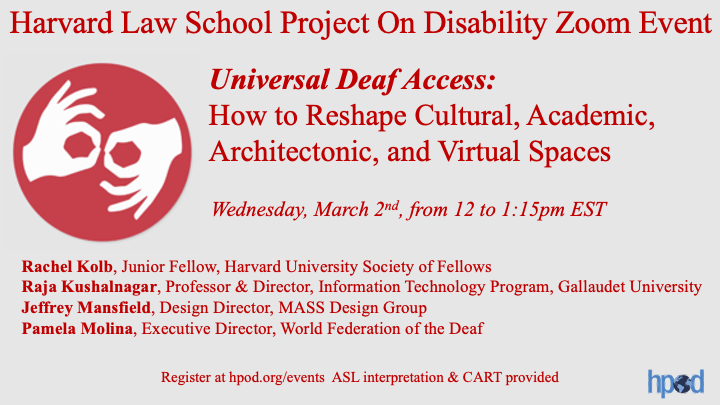HPOD Events
Universal Deaf Access
How to Reshape Cultural, Academic, Architectonic, and Virtual Spaces
On March 2, 2022, HPOD hosted an interdisciplinary all-deaf panel that discussed strategies for promoting greater access for and representation of the deaf community in the mainstream media, classrooms, physical spaces, and the virtual environment.
Rachel Kolb, at Junior Fellow at the Harvard University Society of Fellows, discussed CODA, the coming-of-age story of a child of deaf adults (CODA), who attempts to help her deaf parents' and brother's struggling fishing business in Gloucester, MA, while pursuing her own aspirations of being a singer. CODA won numerous accolades, including three Academy awards and two Screen Actors Guild awards, signaling a breakthrough for deaf representation in film. On the other hand, as Kolb explained, its representation of the deaf community missed certain opportunities to educate about deaf persons' rights that warrant further discussion and reflection at the same time that its contributions to deaf inclusion should be celebrated.
Professor Raja Kushalnagar, who directs Gallaudet University's Information Technology Program, described how visual noise and captioning choices in the design of the information technology environment negatively affect deaf students' learning, among many other implications. While captions, like those provided during this event, can help deaf and hard of hearing individuals access the audio component of web videos and television, they are nevertheless at a disadvantage compared to hearing consumers. While hearing consumers can watch and listen simultaneously, the transformation of audio to text requires deaf viewers to watch two simultaneous visual streams: the video and the textual representation of the audio. This increases the cognitive processing load on deaf viewers, and recognizing this load should inform how information technology platforms seek to incorporate captions specifically and also more broadly to reduce visual noise.
Jeff Mansfield, Design Director at MASS Design Group, discussed how he advances the concept of "radical accessibility" in his work as an architect to transform the built environment, which has been largely constructed by and for hearing individuals and thus presents a variety of surprising challenges to which deaf people have responded with a particular way of altering their surroundings to fit their unique ways-of-being. For example, deaf architects will instinctively design spaces so that they are wide enough for groups of people to have clear sightlines and to form conversation circles that facilitate ASL signing. Beyond these accessibility features, "radical accessibility" aims to center the intersectional experiences and amplifies the agency of Disabled, Black, Indigenous, Latino/a/x, Asian, Deaf, LGBTQIA+ people, thereby leveraging physical spaces to promote care, connection, and community.
Last, the World Federation of the Deaf's Executive Director Pamela Molina described the limitations inherent to widespread perceptions that sign language is merely a “communication tool” or a form of reasonable accommodation. Instead, as she wrote for HPOD’s blog during the International Week of Deaf Persons last fall, this perspective risks overlooking the linguistic and cultural importance of sign language as integral to deaf persons’ identity. Laws or policies that regard language only as an accessibility measure or reasonable accommodation can undermine the collective and cultural aspects of deaf persons' sign language rights, and paradoxically, promote practices that and beliefs that sideline deaf persons from society. Ensuring sign language access, especially in developing contexts, as a linguistic and cultural right can help deaf communities and their members to flourish and maximize their human potential.
View a captioned recording of the event with ASL interpretation below.



